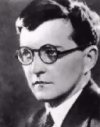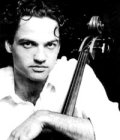
Dmitri Shostakovich
Mstislav Rostropovich, to whom Dmitri Shostakovich dedicated both his cello concertos, once quoted the composer as saying that he had studied all the world's great concertos for cello and orchestra, and that his favorite of them all, perhaps surprisingly, was Saint-SaŽns' First Concerto, in a minor.
Even before beginning work on his own first concerto for cello, Shostakovich spoke to Slava of his enthusiasm for Prokofiev's Symphony-Concerto for cello and orchestra; Shostakovich owned the record, and he had played it so many times that he had quite worn it out.
Each of Shostakovich's two concertos possesses its own distinct overall character, though there is something of an inverse relation between them. The two were written within a seven-year span, yet Shostakovich's experiences leading into each were of significantly different tenor.
Stalin died in 1953, five years after the First Congress of the Composers' Union, where Shostakovich was the most prominent of a number of composers condemned for 'Formalism' in music (a term whose fluid indefiniteness was politically convenient for Shostakovich's enemies in the arts and music bureaucracy of the Soviet Union).
The month following the conclusion of the Congress, Shostakovich finished his Violin Concerto No. 1 in a minor, which he kept on a shelf; this concerto would not see its premiere for another seven years.
Stalin's death made it possible for Russians to catch a tentative breath; there was widespread relief that a nightmare had begun to end, yet also apprehension as to what was to happen next.
In October of 1953, Shostakovich completed his Tenth Symphony, whose premiere in Leningrad that December provoked mixed reaction; composers and critics within the Proletkult (Proletarian Cultural and Educational Organization), such as Tikhon Khrennikov, loudly denounced the new symphony. Artistic friends of the composer, including Khachaturyan, Mravinsky (who conducted the premieres in Leningrad and Moscow) and Denisov, understood the work's great merits. In late March/early April of 1954, angry debates raged in the Composers' Union. Some argued that the Tenth should receive the Stalin Prize; but those prevailed, who argued against the symphony for its tone of ambiguity, devoid of the musical cheer which would rightly represent the Soviet citizen's daily experience.
In August 1954, Shostakovich was nonetheless recognized as a “
People's Artist of the USSR”.
In December of that year, his wife of 22 years, Nina Vasilyevna Varzar, to whom he had dedicated the score of Lady Macbeth of the Mtsensk District, died. At her graveside in Novodevichy Cemetery, music from Shostakovich's Eighth Symphony was played.
In 1936, Lady Macbeth had been the occasion of Shostakovich's precipitous fall from official grace, signaled by the unsigned Pravda editorial, "Muddle Instead of Music"; this experience understandably soured him to the genre of opera. Yet, with Nina's passing, he began to consider revisions to Lady Macbeth (the eventual fruit of this would be the completely revised Katerina Izmailova).
David Oistrakh performed the long-awaited premiere of the First Violin Concerto in October of 1955; Oistrakh would include the concerto in his tour of the US.
In December of 1955, Shostakovich's mother, Sofia Vasilyevna, died.
In the summer of 1956, Shostakovich re-married, rather ill-advisedly; he himself would end the relationship in 1959.
In February of 1957, Shostakovich completed a second piano concerto, this one for his son, Maksim. That March saw the Second All-Union Congress of Soviet Composers; In his keynote address, Khrennikov disparaged Shostakovich's Tenth Symphony, but even he was chided for this personal pique, which was gainsaid by the work's cumulative success. Concerts of the Congress included Shostakovich's Fifth and Tenth Symphonies and the Violin Concerto.
In May of 1958, the Central Committee of the Communist Party passed a resolution reversing the 1948 'Formalist' condemnation of Shostakovich. Privately with Rostropovich and his wife, soprano Galina Vishnevskaya, the composer remarked: “
A historical decree, you know, abrogating the historical decree ... It's really so simple, so very simple”.
In June of 1959, Shostakovich announced he was working on a Cello Concerto.

Jiri Barta
The opening Allegretto of the First Cello Concerto has, for its first theme, a jaunty march (whose cousin will later open the Fifteenth Symphony). The main motive of the second theme is a varied inversion of some material found in the B section of the whirlwind Scherzo of the Tenth Symphony. (These are both a matter of family resemblance, not of mere recycling.) The solo horn (the only brasswind in the First Concerto) announces the beginning of both the development, and the recap.
The Moderato second movement opens with a string elegy, which serves as a ritornello; then the solo horn again sets the entrance of the soloist. The whole movement is one of Shostakovich's trademark long, haunting arcs. The retransition builds magnificently, there is a single timpani stroke, the string elegy returns, and then the bottom opens out: all is a startling stillness, and the cello solo seems to walk on eggshells, playing flautando, a glassine sound which magically cointerpoises the celesta.
The Cadenza is not the brief, bold, busily virtuosic statement which one associates with the concertos of Beethoven, Tchaikovsky or Nielsen; in the main, it is a long, lamenting monody. In passages where the soloist does more of the hoop-jumping normally expected of a cadenza, it is a (composed-out) improvisation upon the first theme from the Allegretto.
The character of the closing Allegro con moto is of a waltz that presses on too fast really to be a waltz. It turns effortlessly into a waltz version of the Allegretto's first theme, and soon becomes a 'metrically true' recap of the march, bringing the concerto full-circle.
While the First Concerto's middle movements are an earnest, brooding core, not to be slighted, the relative cheer of the outer movements seems marginally to carry the day; especially as the recurring march is restored to its original character at the end.
Composed in 1966, the Second Cello Concerto seems to have originated in Shostakovich's thinking as his Fourteenth Symphony (the actual Fourteenth Symphony would be a song cycle for soprano and bass soli, strings and percussion, written in 1969), the idea of a "Cello Symphony" owing something, perhaps, to Prokofiev's Symphony-Concerto with which Shostakovich had been so taken.
The scheme of the Second Concerto's three movements generally recalls the Sixth Symphony: an opening Largo, followed by two faster movements. The Largo is achingly long-breathed and desolate. The second movement's Allegretto begins with an almost-casual insouciance, which has no apparent business following the 15-minute Largo.
The third movement (also Allegretto) opens with a fanfare; although in tempo it seems to relate to the middle movement, there is a great deal of space, resonating with the first. The climax of the third movement is a histrionic exaggeration of the insouciant tune from the second, and is as jarring and dramatic a 're-characterization' of an innocent-in-itself melody, as Shostakovich had accomplished with the march-tune whose gradually waxing variations interrupt the sonata-allegro design of the first movement of the 'Leningrad' Symphony.
The Second Concerto closes with the spooky, 'percolating' percussion which concluded the middle movement of the Fourth Symphony, and which would figure again, yet more prominently, in the Fifteenth Symphony.
~Karl Henning
http://members.tripod.com/~Karl_P_Henning/
Please support Good-Music-Guide.com
by purchasing this CD using this link.

Track Listing
Cello Concerto No.1, E flat maj, Op.107
by Dmitry Shostakovich
Prague Symphony Orchestra
Jiri Barta, cello
Conducted by Maxim Shostakovich
Cello Concerto No.2, G maj, Op.126
by Dmitry Shostakovich
Prague Symphony Orchestra
Jiri Barta, cello
Conducted by Maxim Shostakovich